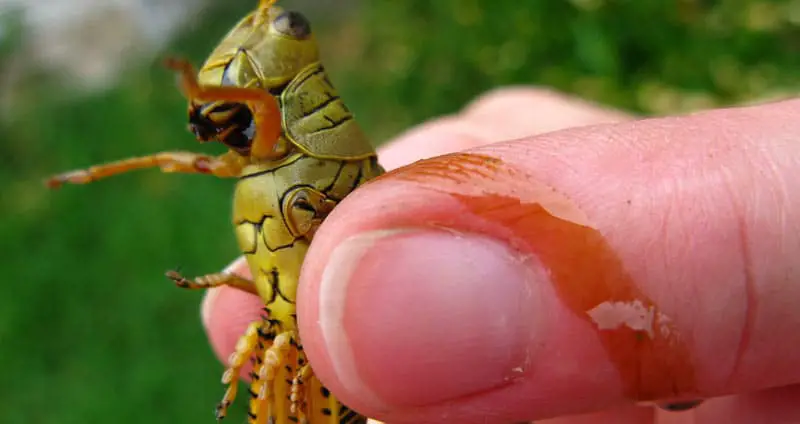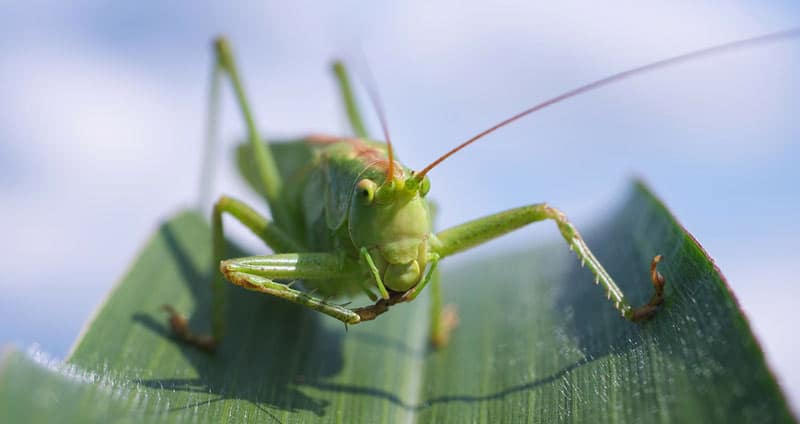Grasshoppers are part of the Orthoptera order, along with crickets and cockroaches. They’re extremely common, herbivorous, and considered a pest because of the large amount of crops that they eat.
While they’re definitely ugly insects, not many people consider them to be dangerous — just a little frightening. Should people be scared of grasshoppers, though?
Do grasshoppers bite or pose some other threat that should make you avoid them at all costs?
Table of Contents
Do Grasshoppers Bite?
Yes, grasshoppers do bite, but it’s extremely uncommon. More specifically, they have the ability to bite — they just don’t choose to most of the time.
Obviously they do possess the ability to “bite” as they eat solid plant matter, but they don’t bite humans as a means of self-defense unless it’s used as a last resort.
As these are wild, unpredictable animals, random bites can occur. If you are bitten, though, don’t worry. Their mouths are very tiny and likely won’t even be able to break skin.
Other Grasshopper Defense Mechanisms
Most grasshoppers only grow to be around 2″ in length and don’t bite for self-defense. How do they defend themselves from danger, then? Do they have other defense mechanisms that may be dangerous to humans?
First and foremost, grasshoppers will use their agility to get away from any danger. This is why they won’t resort to biting you — they’ll simply run away if they feel threatened.
They do have some abilities outside of just fleeing, though, that may be dangerous to humans. This includes poison, stinging, and spitting.
Are Grasshoppers Poisonous?
Most grasshoppers are not poisonous, but some are. Fortunately, even the poisonous grasshoppers aren’t very dangerous, and they’re actually quite easy to spot.
Some species of grasshopper are aposematic, meaning that they have bright coloration to go along with their poison. This makes them easy to spot and easier to stay away from.
If a grasshoppers is poisonous, it’s likely not very poisonous and dangerous to humans. As their predators are often lizards and other small animals, they don’t need potent poisonous to dissaude potential prey.
Also note that a grasshopper’s poison can only be transferred if injested. So, to avoid this problem, simply don’t eat unknown grasshoppers.
Do Grasshoppers Sting?
Grasshoppers don’t sting as they don’t have the proper appendage to do so. However, they do have a similar defense mechanism.
Grasshoppers have spines along their legs, very fine bristles, that can actually cause irritation when pressed into the skin. Spines on their legs can also scrape skin.
This sensation may feel similar to a sting, but is a lot less mild and isn’t actually injecting venom into you.
Humans are definitely vulnerable to this irritation, but it can be avoided by handling a grasshopper gently — not squeezing it in your hand.
Do Grasshoppers Spit?
Yes, grasshoppers do spit! In an act of defensive regurgitation, grasshoppers spit up a brown liquid, often called “tobacco juice” because of its color.
This spit isn’t acidic or really dangerous in any way. It’s essentially made up of partially-digested plant material and digestive enzymes from the grasshopper’s stomach.
In fact, this is hardly a defensive mechanism! Studies have shown that it’s slightly effective in warding off ants, but has almost no effect on larger predators. It may taste bad, but many predators are able to look past that.
All that this grasshopper spit will do is stain your skin and maybe smell a bit. That’s it. No danger to humans here!

Are Grasshoppers Dangerous At All?
In short, no, grasshoppers really aren’t dangerous to humans at all.
The only real threat that some grasshoppers pose is minor poison in amounts that shouldn’t extremely dangerous to humans. Other than that, they just spit nasty liquid and may irritate your arm with their legs.
So, if you come across a grasshopper, don’t worry! They look gross and even act gross, but they rarely if ever bite and don’t pose a threat.
What Could Be Biting You Instead?
As stated, grasshoppers can bite humans, but it’s extremely uncommon. If you think that you were bitten by a grasshopper, there’s a good chance it was actually a similar insect.
Quite a few insects look similar to grasshoppers but prefer a more carnivorous way of life that could result in them biting you.
Look to the insect suborder Ensifera. This suborder contains a variety of different crickets and cricket-like insects like true crickets, camel crickets, katydids, grigs, wetas, and Cooloola monsters.
Many of the isnects within this suborder are carnivorous and are known to bite humans. They also have very similar appearances to grasshoppers.

